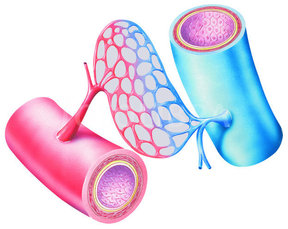
Blood vessels
Our circulatory system is of closed type. i.e. blood flows within blood vessels which are network of closed tube like structures with walls. That is why our circulatory system is also called blood vascular system or cardio-vascular system.
Blood vessels are elastic, muscular tubes that carry blood away from the heart, transport it to the tissues and then return it to the heart. The study of blood vessels is called angiology (Greek: Angeion=vessel; logos=study). There are three types of blood vessels; arteries, veins and capillaries.
- Arteries:
- They are the blood vessels that carry blood away from the heart to different organs and tissues of the body.
- All the arteries carry oxygenated blood except pulmonary artery, which carries deoxygenated blood from heart to the lungs.
- Arteries further branch into small branches called arterioles that give rise to capillaries.
- They have thick elastic muscular walls with a narrow lumen.
- They are deep-seated in the body.
- The blood flows with considerable pressure in the arteries.
- Capillaries:
- They are microscopic vessels with walls mostly one cell thick.
- They allow the exchange of materials by diffusion between the blood and the cells of the organs and hence deliver nutrients to the body tissues under low pressure.
- They are distributed throughout the body except in the dead outer layers of skin and in such places as the layers as the lenses of the eyes.
- Veins:
- They are the blood vessels that carry blood towards the heart from different organs and tissues of the body.
- All the veins carry deoxygenated blood except pulmonary veins, which carry oxygenated blood from lungs to the heart.
- Veins further branch into small branches called venules that give rise to capillaries.
- They have comparatively thinner walls than of arteries with a broad or wide lumen and are generally more flexible than arteries.
- They are superficially distributed in the body.
- The blood flows with minimum or low pressure in the veins.
- Veins have internal one-way valves throughout their length, to stop the blood flowing backwards.
Also see: Differences between arteries and veins in tabulated form
Valves:
- They are muscular flaps hanging freely in the lumen of veins and at the openings of special arteries in the heart.
- Veins usually contain paired semilunar bicuspid valves (two triangular depressions) that permit blood to flow in only one direction, restricting any backflow.
* The valves are like swing doors to ensure the flow of blood in a single direction.
Structure of blood vessels:
The central canal of all the blood vessels is called the lumen. Surrounding the lumen is a wall composed of three layers or tunicae. Arteries and veins slightly differ in structure.
- Tunica interna/ tunica intima (innermost layer): It consists of inner endothelium of long thin cells resting on a basement membrane and an outer elastic membrane of yellow elastic fibre.
- Tunica media (middle layer): It consists of smooth muscle fibres arranged in a circular manner and mixed with a network of elastic fibres also arranged in a circular manner.
*Tunica media is thicker in arteries than in veins in order to resist and withstand the blood pressure exerted by blood on their walls because of the pumping action of the heart.
- Tunica externa/ tuncia adventitia (outermost layer): It consists of loose connective tissue with longitudinally arranged white and yellow fibres. This coat gives strength to and prevents the undue expansion of the blood vessel.
* Capillaries lack the outermost two layers i.e. tunica externa and tunica media. They consist of only the innermost endothelial layer
